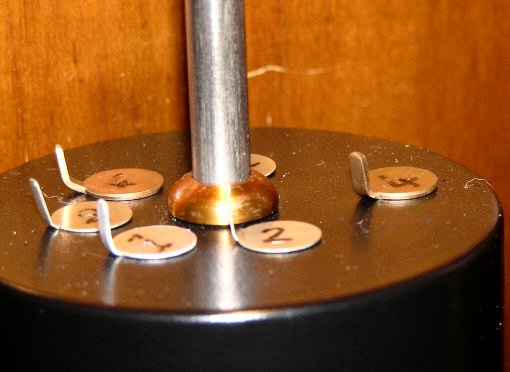The rating nut underneath the pendulum has divisions marked on it which show "10", "20" & "30". These are the amount of difference in seconds per day that a turn, or part turn, will make to the timekeeping. So one full revolution of the nut equals approx. 30 seconds. Getting a 2 or 3 second a day difference becomes very difficult using the rating nut, so the normal method employed is to place small weights on top of the pendulum, as seen in the above picture.
Adding weight will raise the centre of gravity so the rate will increase as the clock runs faster and gains. The best approach is to get the clock running slow by a couple of seconds a day, then add small weights to finish the adjustment off. By removing a small weight you can then make the clock run slower if needed. Some Synchronomes came with a weight tray approximately a third the way down the rod. This is a small circular brass dish on which to place weights. This is tidier than placing them on the top of the bob, and a weight will have more influence on the timekeeping in this position than lower down on top of the bob.
I use a set of weights that came with my Gents Pul-syn-etic clock, these have little tabs on them that you can use with tweezers so as to avoid having to stop the clock. For an idea of the amount of weight used, I find that a 1.55 gram weight or 1 pennyweight (1 dwt) equals 0.8 seconds a day difference - very approximately. The numbers written on the weights above reflecting their respective weights. A '1' being one pennyweight, a '4' being four pennyweights.
Fine adjustments like this need quiet a lot of time before you can see the results, and if you need to stop the clock and restart it, you will find that it generally needs a good half-day or more for it to fully stabilise.
Bear in mind temperature will affect things at this level even though they use an Invar rod. Also if your using a Microset timer to detect small changes, the barometric pressure even has an effect!
In the case of my own clock I find the barometric pressure variations actually have significantly more effect than the temperature variations. This will be different with each clock, as the temperature compensation is totally dependant on the quality of the Invar rod, a metal which is well known for its fickle behaviour.
The Microset timer is a very good tool for spot on adjustment, and allows you to get master clocks working to an accuracy that can never be achieved by just listening to the time pips on the radio!
Original Synchronome Literature and Instructions






